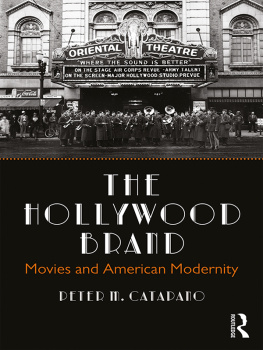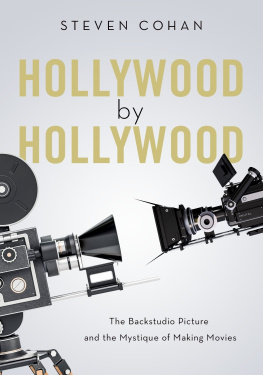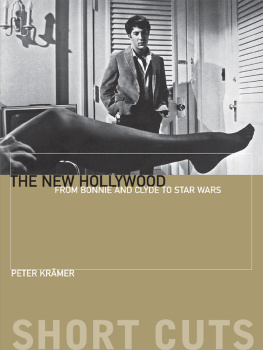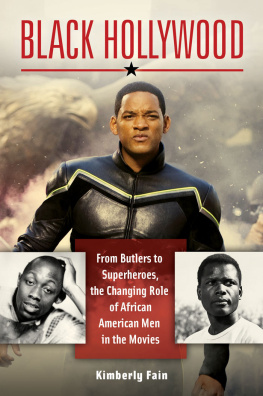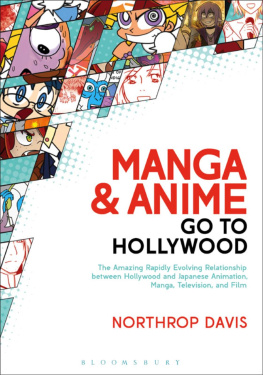THE HOLLYWOOD BRAND
The Hollywood Brand traces the development of the moving picture from its humble roots as an object of mass amusement to its transformation into an art form worthy of exhibition in museums and academic study in leading universities. This book provides historical context to the ideas that coalesce to create the iconic Hollywood brand that comes to define American identity.
Peter M. Catapano is Associate Professor of History at New York City College of Technology.
THE HOLLYWOOD BRAND
Movies and American Modernity
Peter M. Catapano
First published 2018
by Routledge
711 Third Avenue, New York, NY 10017
and by Routledge
2 Park Square, Milton Park, Abingdon, Oxon OX14 4RN
Routledge is an imprint of the Taylor & Francis Group, an informa business
2018 Taylor & Francis
The right of Peter M. Catapano to be identified as author of this work has been asserted by him in accordance with sections 77 and 78 of the Copyright, Designs and Patents Act 1988.
All rights reserved. No part of this book may be reprinted or reproduced or utilised in any form or by any electronic, mechanical, or other means, now known or hereafter invented, including photocopying and recording, or in any information storage or retrieval system, without permission in writing from the publishers.
Trademark notice: Product or corporate names may be trademarks or registered trademarks, and are used only for identification and explanation without intent to infringe.
Library of Congress Cataloging-in-Publication Data
Names: Catapano, Peter, 1961- author.
Title: The Hollywood brand : movies and American modernity / Peter Catapano.
Description: New York : Routledge, 2018. | Includes bibliographical references and index.
Identifiers: LCCN 2017043290 (print) | LCCN 2017055893 (ebook) | ISBN 9781351183260 (ebook) | ISBN 9781351183253 (Web pdf) | ISBN 9781351183246 (ePub) | ISBN 9781351183239 (Mobipocket) | ISBN 9780815395744 (hardback : alk. paper) | ISBN 9780815395751 (pbk. : alk. paper)
Subjects: LCSH: Motion picture industry--California--Los Angeles--History--20th century. | Branding (Marketing) | Motion pictures-Social aspects--United States--History--20th century. | Modernism (Art)--United States
Classification: LCC PN1993.5.U65 (ebook) | LCC PN1993.5.U65 C38 2018 (print) | DDC 384/.80979494--dc23
LC record available at https://lccn.loc.gov/2017043290
ISBN: 978-0-8153-9574-4 (hbk)
ISBN: 978-0-8153-9575-1 (pbk)
ISBN: 978-1-351-18326-0 (ebk)
Entertainment is the objective of the photoplay and we must keep in mind that as entertainment it must appeal to the varied tastes of all people. Other arts generally appeal to a selected group, but the motion picture art, and it is an art, must have universal appeal.
Irving Thalberg, 19291
Hollywood is obviously much more than a description of a mode of film production or a geographical designation. This unique and descriptive name has the characteristics of a brand. The Hollywood brand should not be confused with iconic corporate brand names that also emerged in the early twentieth century like Ford or Coca-Cola. The Hollywood brand has never been interchangeable with one single company that came to dominate an entire industry. In the era before the studio system had been established, Thomas Edisons efforts to retain monopolistic control of his moving picture patents and become the Henry Ford of the American film industry failed. Hollywood as brand unfolded as an idea, not as a company marketing campaign. It emerged even before the industry had created its production centers in Southern California or before the famed Hollywood sign had been constructed over the hills that divide Los Angeles from the San Fernando Valley. It is uncommon as a brand because it existed even before it bore its ubiquitous name.
Nearly everyone has a firm grasp on what Hollywood is, or what it means to go Hollywood. However, this quintessential American term is only a century old and emerged under specific historical circumstances. Hollywood became interchangeable with showmanship, mass entertainment, and the American cinema as the medium of moving pictures became invested with a set of shifting cultural meanings during the first decades of the twentieth century. In a relatively short period of time, moving pictures had been introduced to audiences as a spectacle of technology that spread to traveling shows, vaudeville houses, nickel theaters, and eventually the movie palaces of the studio era. The medium outgrew its sideshow infancy to be recognized as a main attraction. From the nickelodeons to the sound era, moving pictures increasingly came to be defined as a new form of art that had appealed to both the classes and the masses even as the medium became increasingly dominated by the Hollywood studio system.
The studios profited from the enhanced cultural status of the medium among critics as long as the movies remained popular with its mass audience. The Hollywood brand was a means to this end. Famed movie producer Irving Thalberg, the inspiration for F. Scott Fitzgeralds Last Tycoon, captured this transcendent ability of the Hollywood brand to cross the high/low culture divide of entertainment and art. According to Thalberg, other arts generally appeal to a selected group, but the motion picture art, and it is an art, must have universal appeal.2 Who better than Irving Thalbergthe famed quality producerto advance the idea that Hollywoods goal was to produce art of universal appeal that was not elite, but whose artistic value was in part borne out by its embrace by the public? The Hollywood brand described by Thalberg emerged as a unique mash-up or pastiche of art and entertainment and of culture and commerce. Hollywood remains even today a powerful cultural trope to describe quality commercial entertainment even as it has become increasingly detached from the American movie studios or the conditions of its very emergence.
The process of branding was not merely the result of industry advertisement and self-promotionthough such efforts often served to distinguish American studio production from its competitors at home and abroad. Certainly, movie companies advertised and marketed their film titles and their contract stars. However, as film historian Janet Staiger has pointed out, the film business had already by 1915 come to a collective decision that company brand name advertising would be kept to a minimum. The association of specific Hollywood studios with film styles and genres was more the construction of later film historians than a product of contemporary marketing. Instead, the industry preferred the path where brand names would be submerged to product features (genre, stars, plots, spectacle, or realism).3 Those product features were the factors among many others that shaped Hollywood as a brand to become standardized by the studio system. It is these elements that continue to best define the Hollywood brand as a cinematic style.4
In addition, the act of branding, as applied to Hollywood or any other industry, should not be reduced to marketing. Unlike marketing, branding is part of a complex cultural process of signification involving multiple competing individuals and institutions rather than the product of a single vision, or in the case of American cinema, any single studio or group of studios. As marketing expert Douglas B. Holt explains, brands emerge as various authors tell stories that involve the brand and have extraordinary identity value because they address the collective anxieties and desire of a nation.5 While Holts concepts of brands and branding are more likely to find a home in business, rather than academia, he readily acknowledges the importance of anthropological and sociological concepts to his work. This process of signification he describes as authors telling stories also bears a resemblance to what Michel Foucault would describe as a discursive practice. The many conflicting voices of those critically engaged with movies set the parameters for what would come to define American cinema as Hollywood. The emergence of the Hollywood brand was more often than not the unintended result of the individual voices. The discursive dissonance rather than any harmony produced the unstable cultural signifier of Hollywood.


